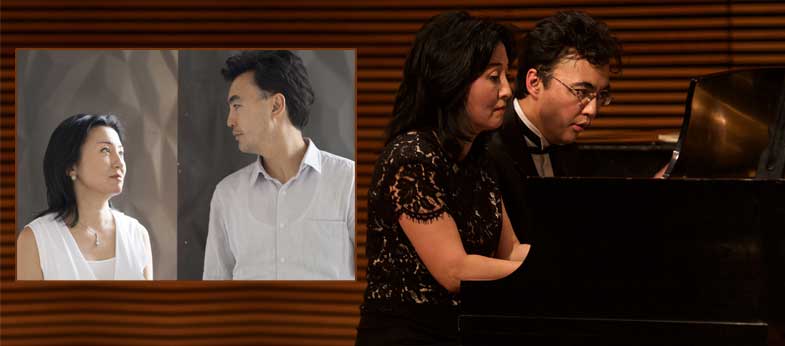

About
Temirzhan Yerzhanov launched his career by winning the First Prize and Gold Medal at the International Robert Schumann Piano Competition in Zwickau, Germany. He has toured extensively in Europe, UK, Russia, China and India.
He has appeared in venues such as London Wigmore Hall, Berlin Konzerthaus, Leipzig Gewandhaus, Moscow Tchaikovsky Conservatory, Dresden Sempergalerie, Paris Salle Gaveau, New York Carnegie Weill Recital and Merkin Halls, Moscow and St. Petersburg Philharmonic Halls and released CDs of Schumann (RCD label) and Prokofiev works including World premiere of Classical Symphony (Con Brio Recordings).
Temirzhan Yerzhanov graduated from the Moscow Tchaikovsky Conservatory under the tutelage of Professor Mikhail Voskressensky. Former faculty member of his alma mater he became an international educator and conductor leading Opera Cultura, youth Orchestra Gradus ad Parnassum and Google Orchestra. He was awarded ‘Best Performance of 2007’ title by San Francisco Classical Voice and ‘Yenbek Sinirgen Qairatkeri”, the highest title in his native Kazakhstan.
Klara Frei has performed in Europe including Switzerland, France, United Kingdom, Czech Republic and Russia, both as a soloist and an accomplished ensemble player. As a soloist she has made frequent appearances with The Kyrgyz National Symphony Orchestra performing major piano concertos by Tchaikovsky, Rachmaninov, Beethoven and Chopin among others. She started piano studies in her native country of Kyrgyzstan at the specialist music school. Winning the First Prize at the National Competition and the prestigious USSR Ministry of Culture Scholarship she continued her education at the famed Moscow Tchaikovsky Conservatory subsequently graduating from Musik-Akademie der Stadt Basel in Switzerland. Klara Frei became a prominent educator in the UK and here in the San Francisco Bay Area. In partnership with her husband she has recorded a CD. Each year she travels to Kyrgyzstan to give free master classes and workshops in music schools and colleges.
Klara Frei and Temirzhan Yerzhanov first met when they were students at the renowned Moscow Tchaikovsky Conservatory. Years later their paths crossed again in London which led them to form a piano duo and life partnership. Now married, the couple is a popular duo in the Bay Area and in concerts throughout Europe, Russia and Central Asia. They are frequently invited to perform in CSMA’s concerts series in Tateuchi Hall. Upcoming engagements include concerts in Kyrgyz National Philharmonic Hall, with the Orchestra Gradus ad Parnassum at Mission Santa Clara and at the Amador Theatre for the Pleasanton Cultural Arts Council.
Program
Program Notes
Written in the last months of Schubert’s life, the Rondo in A Major D. 951 is the composer’s last work for piano four hands. The piece opens softly and sweetly, and flows gently from one melody to another. Towards the piece’s middle section, the harmonies begin to shift, as Schubert plays with different keys. At the end, the rondo theme returns with heavy articulation, a shift from the opening serenity.
For this set of variations, Brahms utilizes themes from Schumann’s last piano work, the 1854 Ghost Variations, composed just before Schumann was admitted to a mental institution. The composition of the original work was fraught by Schumann’s mental conflict between angelic voices and beckoning demons, which led him to attempt suicide after having completed only half the variations. Schumann believed the ghosts of Mendelssohn and Schubert had directed him to undertake the work. Brahms’ 1861 Variations maintained the dark melodic elements throughout, while referencing aspects of Schumann’s music and life. Schumann saw the manuscript in the asylum and had high praise for the piece. The original theme is heard at its clearest in the end, but is lost to the darkness of the piano’s lowest register.
Written in 1841, the Andante and Allegro brillante is one of the few pieces Mendelssohn composed for four hands during the later part of his career. Although the piece seems to flow with a charming lightness throughout, its fast rush of scales makes it one of the most challenging in the repertoire. There is never too much competition between the two pianos, because the main melodic line is passed from one to another without overlap. As a result, the audience hears a succinct musical delight from start to finish.
A charming rondo that exhibits the feel of the salon recital for which it was composed, Schubert’s Rondo in D Major is a light-hearted piece that skips along amusingly. The piece was written in 1818, during a happy time in the composer’s life when he was enjoying playing music in the company of friends and family. When the Rondo was finally published a few years after Schubert’s death, the publisher added a note, “Our friendship is constant,” which calls out the fact that the two pianists cross hands very often towards the Rondo’s end. And indeed, this makes for a great spectacle in live performance.
Written between 1849 and 1851, Ballszenen, (“Ball Scenes”), is a collection of nine dances, each with a different style and country of origin. Schumann was always open to unconventional music and therefore experiments with tonal harmony throughout these dances. For example, the fourth movement, Ungarisch, explores the style hongrois of the Hungarian gypsies of his time, incorporating lively tempos and unique harmonies that stand out from the work’s more classical dances. From here, the dances turn from a generally bright tone to something more pulsating and driven. In the last movement, with its Promenade, the piece climaxes with heavy, rising sets of chords, triumphant and bold.